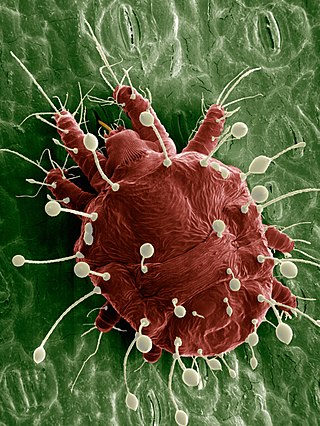
Spider mites are members of the Tetranychidae family, which includes about 1,200 species. They are part of the subclass Acari (mites). Spider mites generally live on the undersides of leaves of plants, where they may spin protective silk webs, and can cause damage by puncturing the plant cells to feed. Spider mites are known to feed on several hundred species of plants.

The peacock mites of the genus Tuckerella are a significant herbivorous pest in the tropics, for example on citrus fruit. Other species dwell in grasses, possibly as root feeders.

Mesostigmata is an order of mites belonging to the Parasitiformes. They are by far the largest group of Parasitiformes, with over 8,000 species in 130 families. Mesostigmata includes parasitic as well as free-living and predatory forms. They can be recognized by the single pair of spiracles positioned laterally on the body.

Raoiella indica, commonly known as the red palm mite, is a species of mite belonging to the family Tenuipalpidae. A pest of several species of palm in the Middle East and South East Asia, it is now becoming established throughout the Caribbean. The invasion of this species is the biggest mite explosion ever observed in the Americas.

Tenuipalpidae, also called flat mites or false spider mites, are a family of mites, closely related to the Tetranychidae. They are reddish and slow-moving and normally feed near the midrib or veins on the underside of leaves. Several species, among them Raoiella indica, are important crop pests. Other common species include Acaricis urigersoni and the Brevipalpus species B. phoenicis, B. californicus, B. obovatus, and B. lewisi.
Amblyseius largoensis is a species of mite in the family Phytoseiidae. It is found in Europe. It is known to feed on Raoiella indica eggs. A. largoensis completes its immature stage in less than a week.

Acalitus is a genus of mites in the family Eriophyidae. These cosmopolitan, microscopic arthropods form galls on various plants, and some species such as Acalitus essigi and Acalitus vaccinii are pests of agricultural significance associated with berry crops. This genus includes the following species:

Aculus is a genus of mites, including the following species:

Musa coccinea, commonly known as scarlet banana or red-flowering banana, is a species of flowering plant in the banana and plantain family Musaceae, native to tropical China and Vietnam. It is a bat-pollinated evergreen perennial, placed in section Callimusa, having a diploid chromosome number of 2n = 20.
Cyperacarus is a genus of flat mites in the family Tenuipalpidae, containing the following species:
Tenuipalpus elegans is a species of mite in the genus Tenuipalpus.

Brevipalpus phoenicis, also known as the false spider mite, red and black flat mite, and in Australia as the passionvine mite, is a species of mite in the family Tenuipalpidae. This species occurs globally, and is a serious pest to such crops as citrus, tea, papaya, guava and coffee, and can heavily damage numerous other crops. They are unique in having haploid females, a condition caused by a bacterium that change haploid males into females.

Brevipalpus is a genus of mites in the family Tenuipalpidae, the flat mites. The genus includes several species that are among the most important economic pests in the flat mite family.
Cilevirus is a genus of viruses in the family Kitaviridae. Plants serve as natural hosts. There are two species: Citrus leprosis virus C and Citrus leprosis virus C2.
Acaricis urigersoni is a species of mite.

Oligonychus ununguis, the spruce spider mite, is a globally widespread pest of spruce. Though not particularly important in the forest, it has been bothersome on planted spruce in the Prairie Provinces, and is considered one of the most important pests of spruce plantations in Ontario. As well, ornamental specimens of spruce and most other conifers throughout the range often suffer damage. The pest is barely visible without the aid of a magnifier and is rarely noticed until discoloured foliage is found on an affected tree. To check for the presence of mites, sharply jar suspected foliage over a piece of white paper, and watch for movement of tiny objects. If a red stain appears when the objects are smeared against the paper, the probability is high that spider mites are present.

Tetranychoidea is a superfamily of mites in the order Trombidiformes. There are about 5 families and more than 2,200 described species in Tetranychoidea.
Magdalena Kathrina Petronella Smith Meyer was a South African acarologist who was regarded as a world authority on plant-feeding mites of agricultural importance and was known as the "mother of red-spider mites of the world". She described more than 700 new species and 25 new genera, mostly of mites of agricultural importance. Meyer was involved in the promotion of biological control of mites using predatory mites, spiders and insects.










